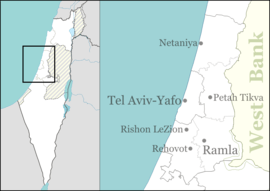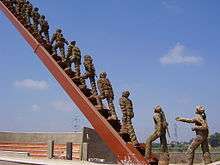Beit Lid suicide bombing
The Beit Lid suicide bombing, (also named Beit Lid massacre[1][2][3][4]) was a suicide attack by Palestinian Islamic Jihad against Israeli soldiers at the Beit Lid Junction on January 22, 1995. It was the first suicide attack by Palestinian Islamic Jihad.
| Beit Lid suicide bombing | |
|---|---|
 The attack site | |
| Location | Beit Lid Junction, Israel |
| Coordinates | 32°19′25″N 34°54′14″E |
| Date | January 22, 1995 9:30 am (GMT+2) |
Attack type | Suicide attack |
| Deaths | 20 Israeli soldiers and one civilian (+ 2 suicide bombers) |
| Injured | 69 Israelis, mostly soldiers |
| Perpetrators | Two Palestinian suicide bombers (Anwar Soukar and Salah Shaaker). Palestinian Islamic Jihad claimed responsibility. |
Background
In 1994, Hani Abed, a Palestinian Islamic Jihad operative, brokered an alliance between Hamas and Palestinian Islamic Jihad. (Hani was later assassinated by Israel). As part of the alliance, Hamas's chief bombmaker, Yahya Ayyash, built the three bombs used by Islamic Jihad for the Beit Lid suicide attack. Each was made using plumber's pipe (one foot long and eight inches (203 mm) wide) and five kilograms of military-grade TNT, surrounded by nails.[5]
The Beit Lid junction is a well-known waypoint towards Netanya. Strategically, it is an important crossroads between Tel Aviv and Haifa located on Highway 4. "On Sunday mornings, Beit Lid was swamped with thousands of young soldiers and aging reservists heading back to military duty from weekend leaves".[5] Ashmoret Prison is located in the southwest corner of the Beit Lid junction. At the time of the bombing, Ahmed Yassin, founder of Hamas, was being held there.[5]
The attack
.jpg)
On 22 January 1995, at approximately 9:30 am, a Palestinian suicide bomber, disguised as an Israeli soldier, approached the bus stop at the Beit Lid junction in central Israel. The bus stop was full of Israeli soldiers who were on their way to their bases after their weekend vacation. The suicide bomber walked into the crowd and detonated the hidden explosives belt he was wearing. About fifteen minutes later a second suicide bomber exploded at the same spot, killing and injuring people wounded in the first explosion, as well as bystanders who had rushed to the scene to assist the victims of the first explosion.
Fatalities

- Soldiers
- Lt. David Ben-Zino, 20, of Ashdod[6]
- Lt. Eyal Levy, 20, of Ashdod – seriously wounded, later died of his wounds[7]
- Lt. Adi Rosen, 20, of moshav Bitzaron[8]
- Lt. Yuval Tuvya, 22, of Jerusalem[9]
- Sgt.-Maj. Anan Kadur, 24, of Daliyat al-Karmel[10]
- Staff-Sgt. Damian Rosovski, 20, of Kadima[11]
- Staff-Sgt. Yehiel Sharvit, 21, of Haifa[12]
- Staff-Sgt. Yaron Blum, 20, of Jerusalem[13]
- Sgt. Maya Kopstein, 19, of Jerusalem[14]
- Sgt. Daniel Tzikuashvili, 19, of Jerusalem[15]
- Sgt. Avi Salto, 19, of Rishon Lezion[16]
- Sgt. Rafael Mizrahi, 19, of Ramat Gan[17]
- Sgt. Eran Gueta, 20, of Ashkelon[18]
- Cpl. Soli Mizrahi, 18, of Ramat Gan[19]
- Cpl. David Hasson, 18, of Ashkelon[20]
- Cpl. Amir Hirschenson, 18, of Jerusalem[21]
- Cpl. Gilad Gal-On, 18, of Herzliya[22]
- Cpl. Ilie Dagan, 18, of Kochav Yair[23]
- Cpl. Eitan Peretz, 18, of Nahariya[24]
- Cpl. Yaniv Weiser, 18, of Givatayim – seriously wounded, later died of his wounds[25]
- Civilians
Aftermath
Israeli Prime Minister Yitzhak Rabin toured the bombing site the next day, walking within yards of a kit bag containing a third bomb. Shaaker had left it there for a third suicide bomber, Shahdi Abed al-Rahim, who never made it to the junction. al-Rahim was to have used the bomb to kill Rabin and the Shabak agents accompanying him. The bomb was later recovered, and provided investigators with more evidence implicating Ayyash.[27]
See also
References
- "But after the Beit Lid massacre, the government approved the construction and sale of 4000 units in occupied land around Jerusalem." Beyer, Lisa. "Can Peace Survive", Time, February 06, 1995.
- "When Arafat called Rabin to express his condolences on the Beit Lid massacre, the prime minister was understandably furious." Karsh, Efraim, Arafat's War: The Man and His Battle for Israeli Conquest, Grove Press, 2003, p. 116. ISBN 0-8021-1758-9
- "The reaction of peace processors in Jerusalem and Washington to the Beit Lid massacre, in which Islamic suicide bombers wiped out a score of Israelis, has been shock, anger, sorrow -- but a determination that terrorist attacks not be allowed to stop the peace process." Safire, William. "Essay; Responding to Terror", The New York Times, January 26, 1995.
- "President Ezer Weizman, a super-dove who initially supported the agreement wholeheartedly, called for a temporary suspension of talks following the Beit Lid massacre on January 22 and again after the February 6 killing in Gaza." Bar-Ilan, David. "Rain of terror - Israeli politics", National Review, March 6, 1995, p. 2.
- Katz, 166-167
- "נזכור את כולם". Retrieved 17 December 2014.
- "נזכור את כולם". Retrieved 17 December 2014.
- "נזכור את כולם". Retrieved 17 December 2014.
- "נזכור את כולם". Retrieved 17 December 2014.
- "נזכור את כולם". Retrieved 17 December 2014.
- "נזכור את כולם". Retrieved 17 December 2014.
- "נזכור את כולם". Retrieved 17 December 2014.
- "נזכור את כולם". Retrieved 17 December 2014.
- "נזכור את כולם". Retrieved 17 December 2014.
- "נזכור את כולם". Retrieved 17 December 2014.
- "נזכור את כולם". Retrieved 17 December 2014.
- "נזכור את כולם". Retrieved 17 December 2014.
- "נזכור את כולם". Retrieved 17 December 2014.
- "נזכור את כולם". Retrieved 17 December 2014.
- "נזכור את כולם". Retrieved 17 December 2014.
- "נזכור את כולם". Retrieved 17 December 2014.
- "נזכור את כולם". Retrieved 17 December 2014.
- "נזכור את כולם". Retrieved 17 December 2014.
- "נזכור את כולם". Retrieved 17 December 2014.
- "נזכור את כולם". Retrieved 17 December 2014.
- "Fatal Terrorist Attacks in Israel Since the Declaration of Principles". MFA. 24 September 2000. Archived from the original on 26 September 2011. Retrieved 2011-09-22.
- Katz, 168
Bibliography
- Katz, Samuel. The Hunt for the Engineer. Lyons Press, 2002. ISBN 1-58574-749-1
External links
| Wikimedia Commons has media related to Beit Lid massacre. |
- Suicide bomb kills 19 at Israel road junction - published on Boston Herald on January 23, 1995
- Two-Stage Bombing Kills 19 At Israeli Military Bus Stop - published on The Washington Post on January 23, 1995
- Blast kills 19 in Israel - published on Sun Journal on January 23, 1995
- Double Bombing Kills 19 Israelis, Wounds 60 - published on Times Daily on January 23, 1995
- Time Magazine interview with Palestinian Islamic Jihad leader Fathi Shkaki four days after the bombing